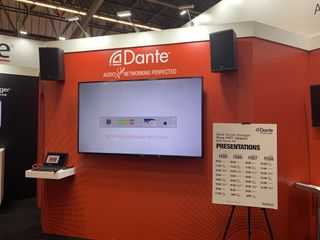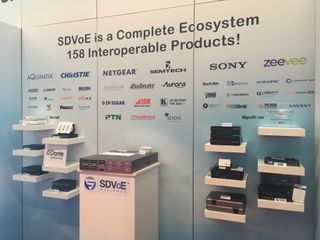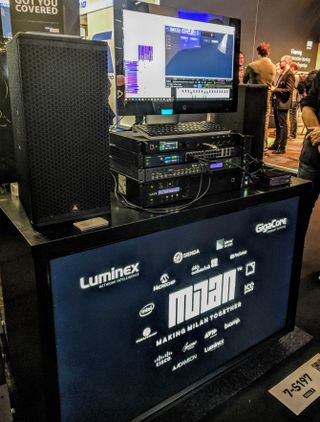Integrated Systems Europe (ISE) has established itself as the premier launch pad of professional audiovisual technologies. ISE is a titan of tech; more than 80,000 technologists attended the show from around the globe. Amid the high-lumen output and high-decibel chatter at the RAI Amsterdam was a clear refrain: move more AV over IP.
This year, the AV over IP conversation pivoted from will the industry embrace it to which approach will integrators adopt? While the notion of format wars is both a misnomer and painfully unoriginal, competing AVoIP platforms including Dante, AVB, and SDVoE, all took to the ISE stage promising to streamline Ethernet network-based AV. What did ISE reveal about the future of these “standards?”
Dante Does Video

Audinate had the biggest story at ISE. The market dominance of Dante’s networked audio solutions—with more than 1,600 enabled products—naturally begged the question: when will Dante do video? Thanks to the new Audinate AV module, audio and video channels can now be individually routed using Dante Controller software. Farewell, matrix switches. Users can send audio channels to any Dante-enabled products currently available while sending video to any Dante AV-enabled screen. The hardware facilitates the interfacing of audio and video with a 1 Gbps network, delivered as a compact, castellated circuit board. What impressed me is that the Dante AV Module is codec-agnostic, allowing manufacturers to utilize the 1 Gb codec of their choice. Dante is still a proprietary standard, however, and licensing fees will apply.
Two Years of SDVoE

ISE 2019 marked the second anniversary of the Software-Defined Video over Ethernet Alliance. With more than 150 interoperable products, SDVoE is supporting more deployments of video-over-IP. Founding members of the SDVoE Alliance, a nonprofit consortium, are Semtech, Aquantia, Christie Digital, NETGEAR, Sony, and ZeeVee. SDVoE is built around the proprietary Aptovision chipset, but there is no licensing fee. SDVoE is planted firmly in the 10 Gbps camp, suggesting that 10 Gbps makes the most sense when all costs, including switchers and endpoints, are considered.
[The 10Gb vs. 1Gb Debate, Part II]
AVNU Milan: Open Standard, IEEE

Members of the Avnu Alliance celebrated the Milan protocol in Amsterdam. Milan supports interoperability at the application layer and combines the time synch and deterministic benefits of the AVB open standard with proAV market-defined device requirements (again, at both the network and the application layers). Members and adopters of the licensing-free AVB standard point to its place with the IEEE network/IT industry as a way to ensure its long-term relevance. IEEE working groups look after, of all things, the Ethernet itself.
Avnu members also shared their Milan news. L-Acoustics has published an open source, free-to-use AVDECC Library that is now Milan compatible with the Milan Discovery, Connection & Control Specification for Listeners & Talkers. This open-source library offers a set of tools for controlling AVB and Milan devices using the AVDECC (IEEE1722.1) protocol and it meets Avnu Milan specifications.
The Final Word
Dante AV, Avnu Milan, and SDVoE are three distinct platforms promising to take AV over IP into the next stage of a more “interoperable” union. All three are investing heavily in education, outreach, and building their unique communities.



